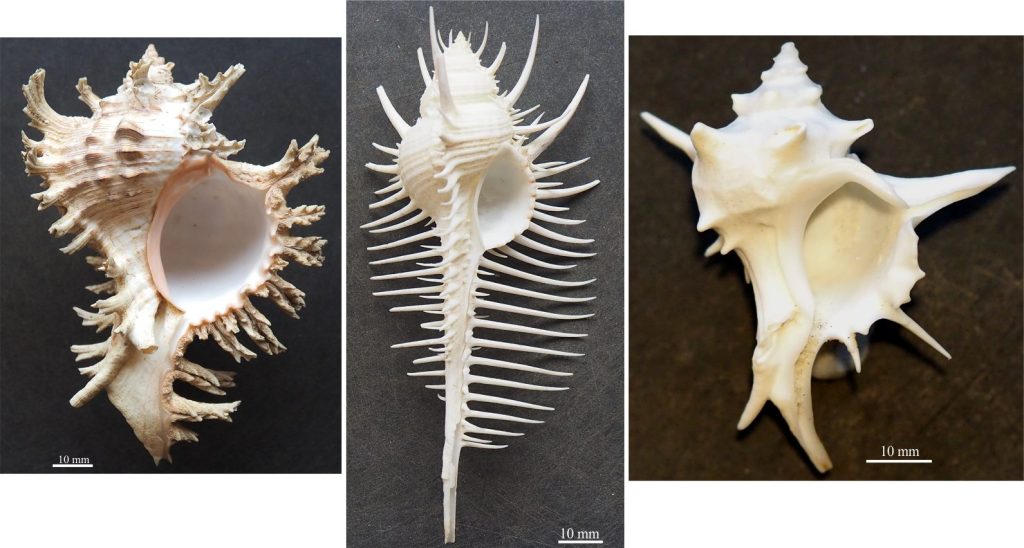

The sartorial splendour of spiny murex – the real show-offs in the world of gastropods. From the left: Chicoreus ramosus (the Ramose Murex, Philippines); Murex pecten (Venus comb Murex, Philippines); Porieria zelandica (New Zealand) – the one I stood on!
Some basic gastropod morphology to assist sedimentological interpretations
This is a companion post to bivalve shell morphology.
The world of snails is morphologically and taxonomically more diverse than that of bivalves. It has been estimated that globally the number of known living gastropod species is about 60,000 compared with about 20,000 bivalve species. In modern and fossil species, morphological variation is manifested by an astounding array of shell size, shape, and ornamentation – the latter exemplified by the sartorial splendour of spiny Murex.
Apart from the obvious morphological differences between bivalves and gastropods, there is also a methodological difference in their taxonomic subdivision. Identification of bivalve taxa is based on a combination of animal anatomy and shell morphology; for the latter, valve dentition is important. In comparison, modern gastropod taxa are based almost entirely on animal anatomy, except at the genus level where shell structure may be included. However, in both cases the identification of fossil forms depends primarily on a comparison of physical attributes with their modern descendants.
The majority of species are marine, but there are fresh water and air-breathing terrestrial species (pulmonates). The morphological attributes of these shells are similar to their marine cousins. There are also shell-less gastropods (nudibranchs) such as the common slug, but these have almost zero preservation potential.
In outcrop and core, gastropods will occur in various states of completeness, as small fragments to complete specimens; their preservation will depend on the kind of gastropod (e.g., thin shelled or thick, tall spires or planispiral, ornamented), the depositional environment, and the degree of sediment reworking (e.g., high or low, wave or tidal current energy). They will probably occur with other shelly fossils and may be accompanied by encrusting biotas such as bryozoa, corals, calcareous algae, and barnacles. There will probably be an associated trace fossil assemblage.
At a certain level of preservation, gastropod fragments will likely be indistinguishable from other molluscs, brachiopods, or barnacles (thin section examination may provide some relief from this dilemma).
However, there are many distinctive morphological elements that will provide a reasonable level of confidence if correctly identified. Some of the commonly used attributes are described here.
Other sources
There are lots… but here are a couple of links to recent texts.
The Paleontological Society provides free access to its Digital Atlas of Ancient Life that contains oodles of explanatory texts, field guides, Apps, and images on the fossil record.
Bringing Fossils to Life: An Introduction to Paleobiology, Donald Prothero. Now in its 3rd Edition.
Orientation
The standard orientation is to place the aperture at the bottom facing the observer, and the spire pointing upward. The aperture may open on the right side of a central column (the columella) indicating dextral coiling; opening on the left side indicates sinistral coiling. Most gastropods have dextral coiling.
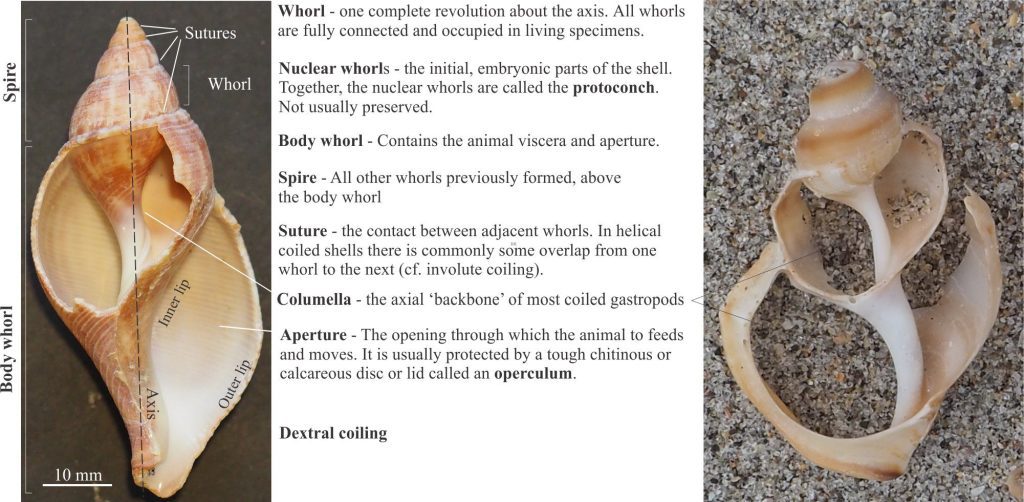

Left: A helically coiled gastropod (Fasciolaria) with part of the shell conveniently broken to reveal the axial columella. Other major morphological components are also identified. Right: Another view of the columella in the genus Struthiolaria. The aperture is facing down in this orientation.
Coiling: Nearly all gastropods produce coiled shells. The variety in gastropod size and shape is primarily a function of the style of coiling. The most familiar shape consists of a body whorl (the open end) and a spire above, coiled in a cork-screw fashion – this is helical coiling. The angle between the body whorl and top of the spire defines the overall shape of the shell; very steep angles present turret shapes and tall spires (e.g., Maoricolpus), and at the other extreme very low angles produce discoidal forms (e.g., Umbonium (Zethalia)). Coiling in a single plane produces planispiral forms which also have bilateral symmetry (like many ammonites). In some species there may be no spire at all, such that the body whorl completely envelops the earlier whorls (involute forms, e.g., Bulla), or non-coiled forms such as the common limpet (e.g., Cellana).
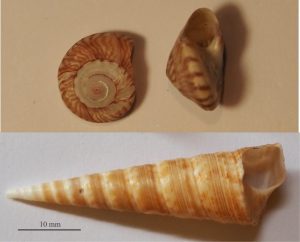

Two extremes of gastropod coiling seen in the common Turret shell (Maoricolpus) and the very low spired, discoidal Umbonium (Zethalia) (top).


The common abalone Haliotis has virtually no spire but does have a very large body whorl and aperture – this is the part where a large foot attaches firmly to hard substrates, such that the animal can withstand significant wave pressure. It is also characterised by an intensely iridescent nacreous layer on the inside surface. It is called Paua (pronounced par wah) in New Zealand.
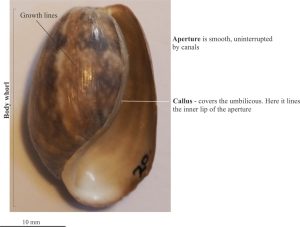

The body whorl of the involute gastropod Bulla completely envelops the earlier whorls. The body whorl extends the entire length of the shell.


Common limpet shells like these Cellana are non-coiled. Like Haliotis, they attach to hard substrates and can withstand significant wave pressures – they like to live in wave-washed zones.
Other morphological elements
The primary morphological elements such as body whorl, spire, and aperture are described above. Additional attributes are shown here for four different species.
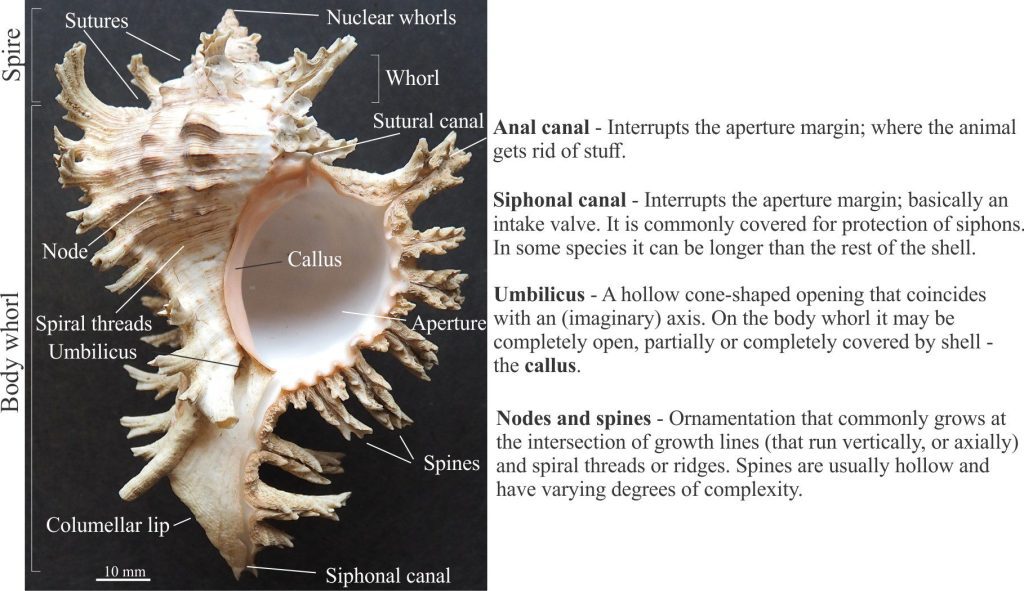

The spiny murex are some of the most spectacular marine snails. This fine example of Chicoreus ramosus contains many of the structural and ornamental attributes that are common to many other species. The spectacle of most murex shells lies in their ornamentation – arrays of spines, nodes, and spiral threads that extend around whorl circumferences. Many of these calcareous growths form at the intersections with growth lines – the growth lines in most gastropods extend the length of the shell (and not its circumference).
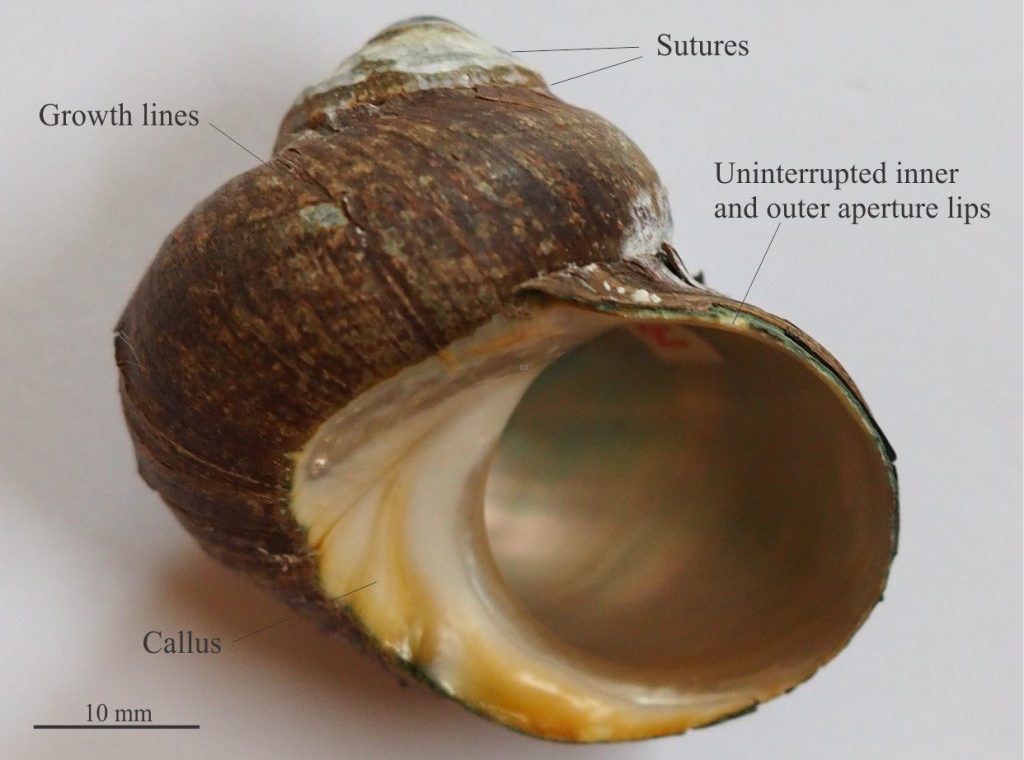

In the turbinate Cat’s Eye shell (Turbo) the body whorl is about the same height as the spire. The whorls are inflated – compare them to whorls in the turret shell shown above. The margins of the aperture are continuous, lacking interruptions by either siphonal or anal canals. The umbilicus is completely covered by a broad callus that extends from the inner lip of the aperture. Internally, the shell has a nacreous lining of aragonite. The operculum is a solid calcium carbonate disc (the cat’s eye) that has high preservation potential compared with the chitinous opercula in many gastropods.
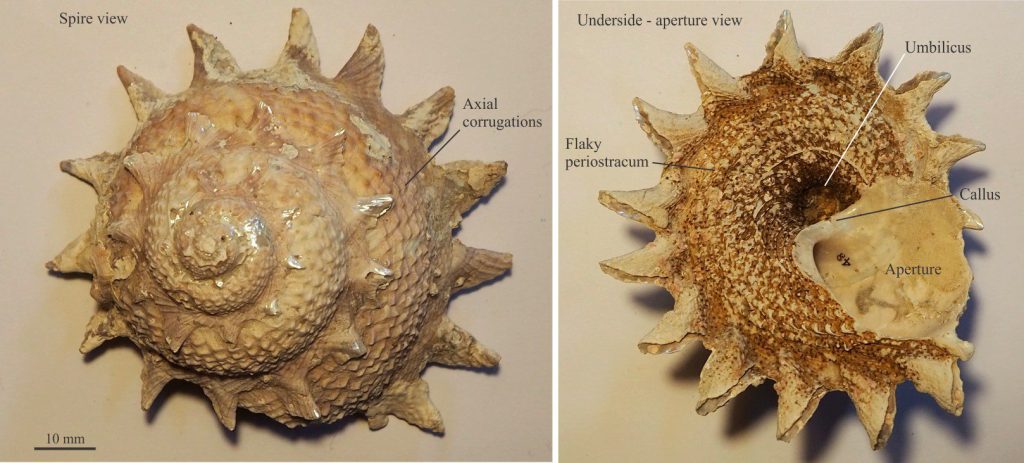

The turbinid shell Cookia sulcata (NZ) that has a conical shape with a flattish base and large, solid spines evenly spaced around the sutures. Whorls are inflated. The umbilicus is almost completely open (partly covered by the callus). The brown covering seen on the underside is the periostracum, an organic layer secreted by the organism to help protect the shell from abrasion – it has low preservation potential.
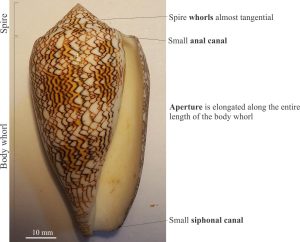

The elongate, relatively narrow aperture is typical of Cone shells and Cowries. The shell surface is smooth, lacking surface ornamentation. Unfortunately, shell colour is rarely a preservable property.
Other posts in this series
Echinoderm morphology for sedimentologists
Trilobite morphology for sedimentologists
Brachiopod morphology for sedimentologists
Cephalopod morphology for sedimentologists
Bivalve shell morphology for sedimentologists
Carbonates in thin section: Molluscan bioclasts
Mineralogy of carbonates; skeletal grains
Mineralogy of carbonates; non-skeletal grains
Mineralogy of carbonates; lime mud
Mineralogy of carbonates; classification
Mineralogy of carbonates; carbonate factories
Mineralogy of carbonates; basic geochemistry
Mineralogy of carbonates; cements
Mineralogy of carbonates; sea floor diagenesis
Mineralogy of carbonates; Beachrock
Mineralogy of carbonates; deep sea diagenesis
Mineralogy of carbonates; meteoric hydrogeology
Mineralogy of carbonates; Karst
Mineralogy of carbonates; Burial diagenesis
Mineralogy of carbonates; Neomorphism
Mineralogy of carbonates; Pressure solution
Mineralogy of carbonates: Stromatolite reefs
